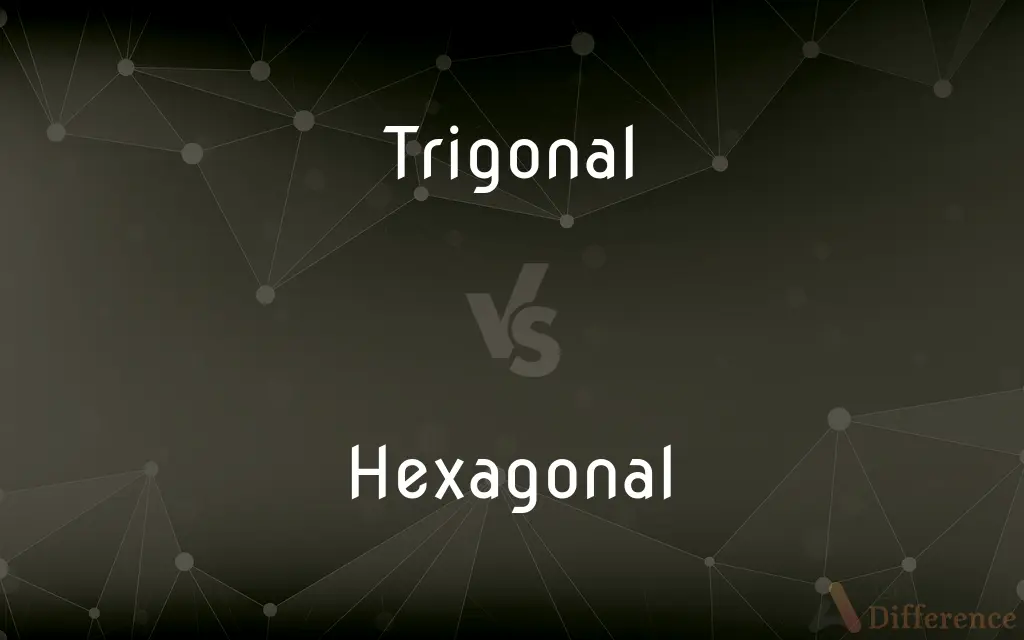Trigonal vs. Hexagonal — What's the Difference?
Edited by Tayyaba Rehman — By Maham Liaqat — Updated on April 18, 2024
Trigonal crystal systems have a threefold symmetry axis, typical in minerals like quartz; hexagonal systems feature a sixfold axis, seen in beryl.

Difference Between Trigonal and Hexagonal
Table of Contents
ADVERTISEMENT
Key Differences
In crystallography, the trigonal system is characterized by its threefold rotation symmetry, which significantly influences the crystal shapes and lattice structures. On the other hand, the hexagonal system is distinguished by a sixfold symmetry axis, resulting in different crystal habits and properties.
The trigonal system often presents rhombohedral lattice structures, which are less common in other systems. Whereas the hexagonal system predominantly features hexagonal prisms and pyramids in its crystal forms, illustrating the impact of its higher symmetry.
Minerals such as quartz and tourmaline fall under the trigonal system, showcasing a variety of crystal forms influenced by their symmetry. In contrast, hexagonal systems include minerals like beryl and apatite, which typically exhibit elongated hexagonal structures.
Optical properties also differ; trigonal crystals can exhibit uniaxial optical behavior similar to hexagonal crystals. However, their internal lattice arrangements cause variations in light propagation and optical activity.
In terms of technological applications, both trigonal and hexagonal materials are vital. Trigonal quartz is extensively used in electronics due to its piezoelectric properties. Meanwhile, hexagonal beryl (emerald) is highly prized in jewelry but also studied for its unique geological formation processes.
ADVERTISEMENT
Comparison Chart
Symmetry Axis
Threefold
Sixfold
Common Minerals
Quartz, Tourmaline
Beryl, Apatite
Crystal Forms
Rhombohedral
Hexagonal prisms
Optical Behavior
Uniaxial
Uniaxial
Technological Uses
Electronics, Timepieces
Jewelry, Geological Studies
Compare with Definitions
Trigonal
Involving three intersecting planes.
Trigonal symmetry is evident in the molecular structure of benzene.
Hexagonal
Pertaining to a six-sided polygon or shape.
Honeycomb cells are hexagonal in form.
Trigonal
Pertaining to a form derived from triangular shapes.
The trigonal planar molecule features evenly spaced atoms.
Hexagonal
Relating to a crystal system with a sixfold symmetry axis.
Beryl crystals are typical of the hexagonal system.
Trigonal
Relating to a crystal system with threefold symmetry axes.
Quartz is a prime example of a trigonal crystal.
Hexagonal
Involving arrangements of six elements.
Hexagonal packing is efficient in stacking spherical objects.
Trigonal
A geometric arrangement involving three angles.
The trigonal pyramidal geometry is common in ammonia.
Hexagonal
Referring to structures or designs featuring six units.
The pavilion's roof was designed with a hexagonal framework.
Trigonal
Associated with a division into three parts.
Some flowers exhibit trigonal symmetry in their petals.
Hexagonal
Geometric arrangement with six angles.
The hexagonal pattern is preferred for fabricating certain types of tiles.
Trigonal
Rhombohedral.
Hexagonal
Having six sides.
Trigonal
Having three angles and three sides, triangular.
Hexagonal
Containing a hexagon or shaped like one.
Trigonal
(crystallography) Of or pertaining to a crystal system with three equal and equally inclined but not perpendicular axes.
Hexagonal
(Mineralogy) Having three equal axes intersecting at angles of 60° in one plane and one axis of variable length that is perpendicular to the others.
Trigonal
(anatomy) Relating to the trigone
Hexagonal
(geometry) Having six edges, or having a cross-section in the form of a hexagon.
Nuts in engineering are generally hexagonal.
Trigonal
Having three angles, or corners; triangular; as, a trigonal stem, one having tree prominent longitudinal angles.
Hexagonal
(crystallography) Having three equal axes which cross at 60° angles, and an unequal axis which crosses the others at 90° angle.
Trigonal
Having three-fold symmetry
Hexagonal
Having six sides and six angles; six-sided.
Hexagonal
Having six sides or divided into hexagons
Common Curiosities
How do trigonal and hexagonal systems differ in their crystal forms?
Trigonal systems typically show rhombohedral forms whereas hexagonal systems are noted for their hexagonal prisms.
What are the practical applications of trigonal crystals?
Trigonal crystals like quartz are extensively used in electronics and timekeeping devices due to their piezoelectric properties.
What are the characteristics of a hexagonal crystal system?
Hexagonal crystal systems are characterized by sixfold symmetry axes and include the hexagonal and trigonal crystal classes.
What defines a trigonal crystal system?
Trigonal systems are defined by their threefold symmetry axes and rhombohedral or scalenohedral crystal classes.
Can minerals belong to both trigonal and hexagonal systems?
Yes, some minerals like calcite can be categorized under both depending on their crystallographic and optical properties.
What makes hexagonal crystals valuable in jewelry?
Hexagonal crystals such as beryl (emerald) are valued for their aesthetic qualities and rarity.
How do trigonal and hexagonal systems impact optical properties?
Both can exhibit uniaxial optical properties, but their internal structure affects light propagation differently.
Which minerals are exclusively found in the trigonal system?
Minerals like quartz and tourmaline are exclusive to the trigonal system.
What types of crystal shapes are common in the trigonal system?
Rhombohedral and scalenohedral shapes are commonly associated with the trigonal system.
Which minerals are exclusive to the hexagonal system?
Minerals like beryl and apatite are typically found in the hexagonal system.
Are trigonal and hexagonal systems considered the same in mineralogy?
They are treated as distinct systems but share some similarities in symmetry and crystallographic terms.
Which system has a higher degree of symmetry?
The hexagonal system has a higher degree of symmetry with a sixfold axis compared to the threefold axis of the trigonal system.
What is the difference in symmetry between trigonal and hexagonal systems?
Trigonal systems have a threefold symmetry axis, whereas hexagonal systems feature a sixfold axis.
What types of crystal shapes are prevalent in the hexagonal system?
Hexagonal prisms and hexagonal pyramids are typical in the hexagonal system.
Can trigonal and hexagonal crystals both show uniaxial behavior?
Yes, both types of crystals can exhibit uniaxial optical behavior, although it originates from their respective symmetry and structural peculiarities.
Share Your Discovery

Previous Comparison
Floatability vs. Buoyancy
Next Comparison
Landing vs. TouchdownAuthor Spotlight
Written by
Maham LiaqatEdited by
Tayyaba RehmanTayyaba Rehman is a distinguished writer, currently serving as a primary contributor to askdifference.com. As a researcher in semantics and etymology, Tayyaba's passion for the complexity of languages and their distinctions has found a perfect home on the platform. Tayyaba delves into the intricacies of language, distinguishing between commonly confused words and phrases, thereby providing clarity for readers worldwide.














































